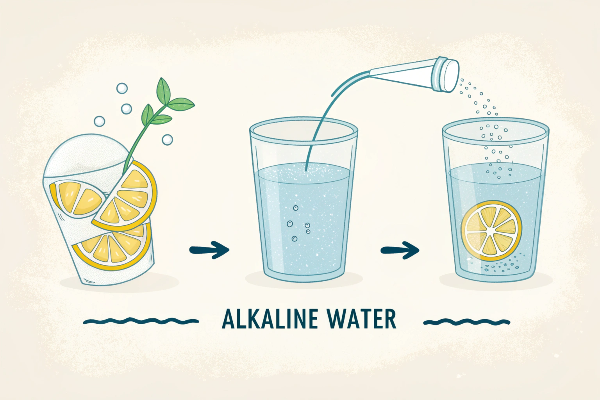Struggling with material limitations like corrosion or poor conductivity? You need better performance, but budgets are tight. Electroplating offers a versatile, cost-effective solution across many industries.
Electroplating enhances products by adding thin metal layers. Key uses include preventing rust on car parts, improving conductivity in electronics, protecting aerospace components, ensuring medical device safety, and cutting manufacturing costs.
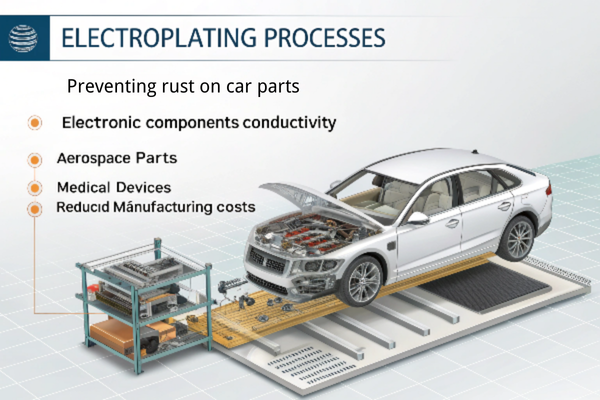
Electroplating might seem complex, but its applications are everywhere, solving critical problems in surprising ways. Let’s explore how this process makes everyday products and high-tech components better, stronger, and more reliable.
How does electroplating prevent corrosion in automotive parts?
Worried about rust destroying car parts and leading to costly repairs? Salt, moisture, and road grime constantly attack vehicles. You need reliable protection to extend vehicle life and maintain safety.
Electroplating creates a protective metal barrier on automotive parts.1 Zinc and nickel coatings are common examples. They sacrifice themselves chemically or block moisture, significantly slowing down or stopping rust formation.
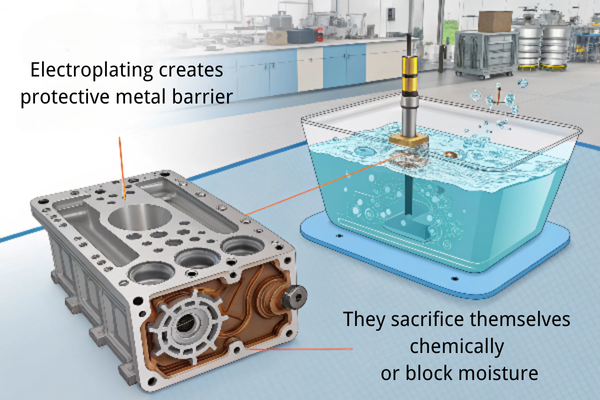
Let’s dive deeper into how this works. The goal isn’t just understanding anti-corrosion; it’s about extending part life and saving money. Think about brake systems or engine components constantly exposed to harsh conditions. Without protection, they fail much faster. In my experience working with automotive suppliers, the difference is stark.
Key Plating Methods for Corrosion Resistance
We often use specific metals depending on the part and its environment.
- Zinc Plating2: This is a workhorse for preventing rust on steel parts like fasteners, brackets, and chassis components. Zinc acts as a sacrificial layer. It corrodes preferentially to the steel underneath. Sometimes, chromate conversion coatings are added over the zinc for even better protection and a specific appearance (like yellow or clear).
- Nickel Plating3: Nickel offers excellent corrosion resistance and a bright, durable finish. It’s often used on bumpers, trim, and exhaust components. Sometimes, a layer of copper is applied before the nickel for better adhesion and added protection. Combining nickel with chromium (nickel-chrome plating) provides top-tier durability and shine.
Quantifying the Benefits
The impact is measurable. Data from industry tests often shows significant life extension.
| Plating Type | Component Example | Typical Life Extension Factor | Primary Benefit |
|---|---|---|---|
| Zinc (with chromate) | Brake Calipers | 3x – 5x | Sacrificial Protection |
| Nickel-Chrome | Bumpers, Trim | 5x – 10x | Barrier & Appearance |
| Electroless Nickel | Fuel System Parts | 4x – 7x | Uniform Coverage |
Using electroplating for automotive corrosion resistance4 isn’t just a minor improvement. Applying zinc plating to car parts5 or other anti-rust metal coatings for vehicles6 dramatically reduces warranty claims and maintenance costs, which is a huge factor for manufacturers and owners. It’s a proven way to make vehicles last longer in tough environments.
Why is electroplating critical for aerospace components?
Aerospace components face extreme conditions: intense heat, friction, and corrosive atmospheres. Material failure isn’t an option. Engineers need materials that are strong, lightweight, and incredibly resistant to wear and tear.
Electroplating provides essential surface properties for aerospace parts. It adds layers that resist wear, heat, and corrosion without significantly increasing weight. This enhances the performance and lifespan of critical components like turbine blades and landing gear.
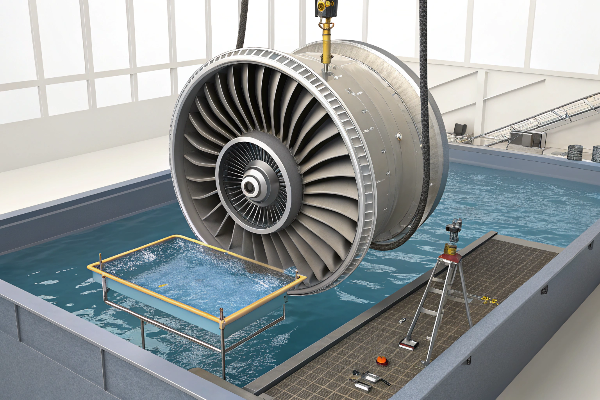
The demands in aerospace are unique. Every gram matters, yet components must withstand forces and temperatures far beyond everyday applications. Electroplating allows engineers to use strong but lightweight base materials (like titanium or aluminum alloys) and then add specialized surface characteristics precisely where needed. It’s a cornerstone of modern aerospace electroplating applications7.
Enhancing Performance in Extreme Environments
Specific plating types are chosen for their ability to handle punishing conditions.
- Nickel Plating (and Alloys): Nickel-based coatings, including electroless nickel and specialized alloys like Nickel-Cobalt or Nickel-Tungsten, are widely used. They provide excellent hardness and wear resistance. Think about parts that rub or slide, like actuators or landing gear components. Nickel plating turbine blades8, often with complex alloys containing elements like phosphorus or boron, helps them resist the incredibly high temperatures and erosive forces inside a jet engine. Industry leaders like Boeing and NASA rely heavily on these coatings.
- Chromium Plating9: Hard chrome plating is famous for its exceptional hardness and low friction. It’s applied to surfaces needing extreme wear resistance, such as hydraulic cylinders and piston rods in landing gear and flight control systems.
- Cadmium/Zinc-Nickel Plating: While cadmium usage is declining due to environmental concerns, it offered excellent corrosion protection, especially in marine environments, and good lubricity for fasteners. Zinc-Nickel alloys are increasingly used as a replacement, offering comparable corrosion resistance necessary for fasteners and structural components exposed to the elements.
Balancing Weight and Durability
Electroplating allows for optimization that bulk materials can’t achieve.
| Feature Requirement | Common Base Material | Electroplating Solution | Benefit | Example Component |
|---|---|---|---|---|
| High Wear Resistance10 | Steel, Aluminum | Hard Chromium, Electroless Nickel | Extends life under friction | Hydraulic Pistons |
| High Temp Resistance11 | Superalloys, Steel | Nickel Alloys (e.g., Ni-Co), Platinum | Prevents degradation at high heat | Turbine Blades, Nozzles |
| Corrosion Resistance | Aluminum, Steel | Cadmium (decreasing), Zinc-Nickel, Nickel | Protects from environmental attack | Fasteners, Structures |
| Lightweight Strength | Titanium, Aluminum | Titanium Nitride (PVD/CVD*), Nickel | Adds surface function w/o much mass | Various structural parts |
(Note: While TiN is often PVD/CVD, similar functional coatings can involve electroplating steps or principles.)
Using lightweight corrosion-resistant coatings12 achieved through electroplating is not just an improvement; it’s an enabling technology. It allows aircraft to fly faster, higher, and longer, carrying heavier payloads safely, pushing the boundaries of aerospace engineering.
Can electroplating improve medical device safety?
Medical devices must be safe, reliable, and biocompatible. Materials contacting the body cannot cause harm, and instruments need to be sterile. Failures or infections can have severe consequences, so meeting strict regulations (like FDA standards) is paramount.
Yes, electroplating significantly improves medical device safety. It applies biocompatible layers like gold or platinum to implants and instruments. It also adds antibacterial properties using silver plating, reducing infection risks associated with devices like catheters.
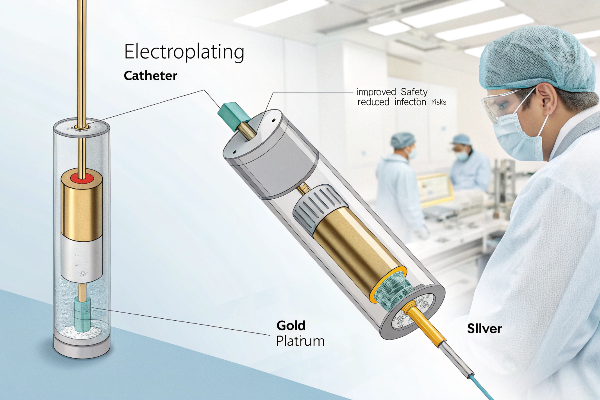
In the medical field, surface properties are critically important. The bulk material provides the structure, but the surface interacts directly with the body or needs specific properties for function and safety. I remember working on a project involving surgical tools where the right coating made a huge difference in performance and ease of sterilization. Medical device electroplating safety13 is a major focus.
Key Plating Applications for Safety and Function
Different metals offer specific benefits crucial for medical applications.
- Gold and Platinum Plating: These precious metals are highly biocompatible and inert, meaning they don’t react with body tissues or fluids. They are often used for coating implantable devices like pacemakers, stents, and defibrillator electrodes. Gold’s radiopacity (visibility on X-rays) is also useful for guiding placement. Using FDA-approved metal coatings14 often involves these inert metals.
- Silver Plating: Silver has well-known natural antibacterial properties. Antibacterial silver plating15 is applied to devices like catheters, wound dressings, and surgical instruments to help prevent hospital-acquired infections. The silver ions disrupt bacterial cell functions, reducing the risk of biofilm formation.
- Nickel and Chromium Plating: While direct contact with nickel can be an issue for sensitized individuals, nickel plating (often as an underlayer) and chromium plating are used on surgical instruments for durability, corrosion resistance, and ease of cleaning/sterilization. The smooth, hard surface resists scratches where bacteria could hide.
Meeting Biocompatibility and Regulatory Standards
The choice of plating is heavily influenced by safety and regulatory requirements.
| Plating Metal | Key Safety Benefit | Typical Medical Application | Regulatory Consideration16 |
|---|---|---|---|
| Gold | Biocompatible17, Inert | Implants, Electrodes | Excellent tissue compatibility |
| Platinum | Biocompatible17, Inert, Hard | Implants, Surgical Tools | High inertness, durability |
| Silver | Antibacterial | Catheters, Wound Dressings | Controlled ion release vital |
| Titanium Nitride (PVD/CVD*) | Biocompatible17, Hard, Wear-Resistant | Surgical Tools, Orthopedic Implants | Often used on implants |
| Nickel/Chrome | Durability, Cleanability | Surgical Instruments (handles) | Potential sensitization (Ni) |
(Note: TiN is often PVD/CVD but relevant in surface modification for medical devices.)
Electroplating18 provides tailored surfaces essential for modern medical technology. By carefully selecting coatings, manufacturers can enhance device function, improve patient outcomes by ensuring biocompatibility, and actively combat infection risks, all while meeting the stringent demands of health authorities like the FDA.
How to reduce manufacturing costs with electroplating?
Manufacturers, especially small and medium-sized enterprises (SMEs), constantly seek ways to cut costs without sacrificing quality. Using expensive materials19 like solid stainless steel or precious metals can make products uncompetitive. How can performance be maintained affordably?
Electroplating allows manufacturers to use less expensive base materials (like steel or brass) and cover them with a thin layer of a more desirable metal. This provides the needed surface properties (like corrosion resistance20 or appearance) at a fraction of the cost of using the solid, expensive material.
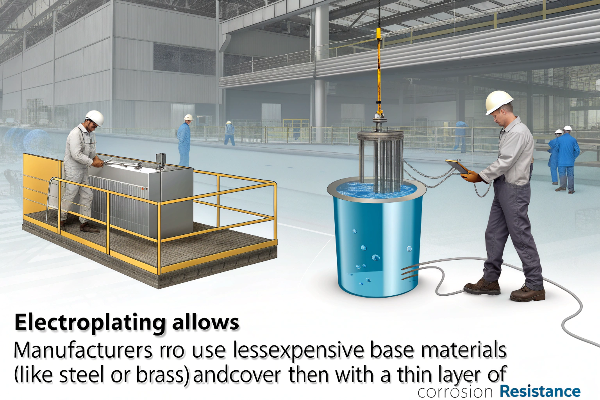
This is one of the most practical, widely used aspects of electroplating. Think about everyday items – kitchen faucets, decorative hardware, even fashion jewelry. Often, they look and feel premium, but electroplating makes that possible without breaking the bank. It’s a core strategy for low-cost electroplating solutions21.
Achieving High-End Properties Economically
The principle is simple: use an affordable core, add a functional or aesthetic surface.
- Replacing Stainless Steel: Need corrosion resistance but stainless steel is too costly? Plating regular steel with nickel or chrome (nickel plating vs. stainless steel22) can provide excellent protection and a similar appearance for many applications, often saving significantly on material expenses. I’ve seen manufacturers reduce material costs by up to 40% this way on certain components.
- Decorative Finishes: Want the look of gold, silver, or bronze without the price tag? Electroplating applies incredibly thin layers of these precious metals onto cheaper base materials like brass or zinc alloys. This is standard practice in jewelry, plumbing fixtures, and decorative hardware. Copper plating followed by a clear coat can even mimic rose gold.
- Improving Solderability/Conductivity: Instead of using solid silver contacts, plating copper or brass contacts with a thin layer of silver or tin provides the necessary solderability or conductivity for electronic components, achieving the goal of electroplating to save material costs23.
Cost Comparison Examples
The savings become clear when comparing bulk material costs to plating costs.
| Application Requirement | Expensive Solid Material | Cheaper Base + Plating | Estimated Cost Saving Potential (Material Only) | Example Product |
|---|---|---|---|---|
| Corrosion Resistance & Shine | Stainless Steel | Steel + Nickel/Chrome Plate | 30-50% | Hand tools, fasteners |
| Gold Appearance | Solid Gold | Brass + Gold Plate | 90-99%+ | Fashion jewelry |
| Silver Appearance | Solid Silver | Zinc Alloy + Silver Plate | 80-95% | Decorative hardware |
| Good Solderability | Silver Alloy | Copper + Tin/Silver Plate | 50-70% | Electronic terminals |
These savings are particularly impactful during large-scale production where material costs add up quickly. While plating involves processing steps (cleaning, plating bath, rinsing), the drastic reduction in raw material expense often makes it the most economical approach. By cleverly combining materials, electroplating helps businesses deliver quality products at competitive prices.
Conclusion
Electroplating24 is a versatile and vital process. It enhances products across industries, from cars and electronics to aerospace and medicine, primarily by improving durability25, conductivity26, and safety while often reducing costs.
-
Explore how electroplating works to protect automotive parts from corrosion and extend their lifespan. ↩
-
Learn about zinc plating’s sacrificial properties and its effectiveness in rust prevention for automotive components. ↩
-
Discover the benefits of nickel plating for automotive parts and its role in providing a durable finish. ↩
-
Explore how electroplating can significantly enhance vehicle durability and reduce maintenance costs, making it a smart investment for manufacturers. ↩
-
Learn about the advantages of zinc plating in extending the life of car parts and its role in reducing warranty claims. ↩
-
Discover the top anti-rust coatings available for vehicles and how they can protect your investment from corrosion. ↩
-
Explore this link to discover cutting-edge techniques and innovations in aerospace electroplating that enhance component performance and durability. ↩
-
Learn how nickel plating enhances turbine blade performance, ensuring they withstand extreme conditions in jet engines. ↩
-
Find out how chromium plating provides exceptional hardness and wear resistance for critical aerospace components, ensuring reliability and safety. ↩
-
Discover the significance of High Wear Resistance in extending the life of components under friction, crucial for various applications. ↩
-
Learn about materials with High Temp Resistance and how they prevent degradation in extreme conditions, vital for aerospace and industrial uses. ↩
-
Explore this link to understand how lightweight corrosion-resistant coatings enhance performance in aerospace and other industries. ↩
-
Explore this link to understand how electroplating enhances the safety and reliability of medical devices, ensuring better patient outcomes. ↩
-
Learn about FDA-approved coatings that ensure medical devices meet safety standards, crucial for patient health and device efficacy. ↩
-
Discover the science behind antibacterial silver plating and its role in preventing infections in medical devices, a key to patient safety. ↩
-
Navigating regulatory standards is essential for compliance in medical device manufacturing. This resource will guide you through the requirements. ↩
-
Understanding biocompatibility is crucial for ensuring patient safety and device effectiveness. Explore this link for in-depth insights. ↩ ↩ ↩
-
Electroplating is key to improving device functionality and safety. Discover how it impacts modern medical technology in this informative article. ↩
-
Find out about cost-effective alternatives to expensive materials that can help manufacturers stay competitive without compromising quality. ↩
-
Learn how electroplating enhances corrosion resistance, ensuring durability and longevity in products, which is crucial for manufacturers. ↩
-
Explore this link to discover effective and affordable electroplating solutions that can help reduce manufacturing costs while maintaining quality. ↩
-
Explore this link to understand how nickel plating can save costs while providing corrosion resistance and aesthetic appeal. ↩
-
Discover how electroplating can significantly lower material expenses while maintaining quality in various applications. ↩
-
Explore the advantages of electroplating and how it enhances products in multiple sectors, from automotive to aerospace. ↩
-
Learn how electroplating significantly increases the lifespan and resilience of products, making them more reliable and cost-effective. ↩
-
Discover how electroplating boosts electrical conductivity, crucial for electronics and other applications, ensuring better performance. ↩



